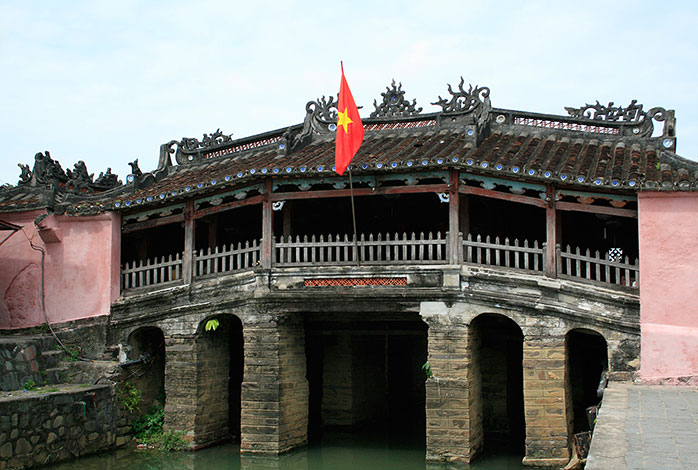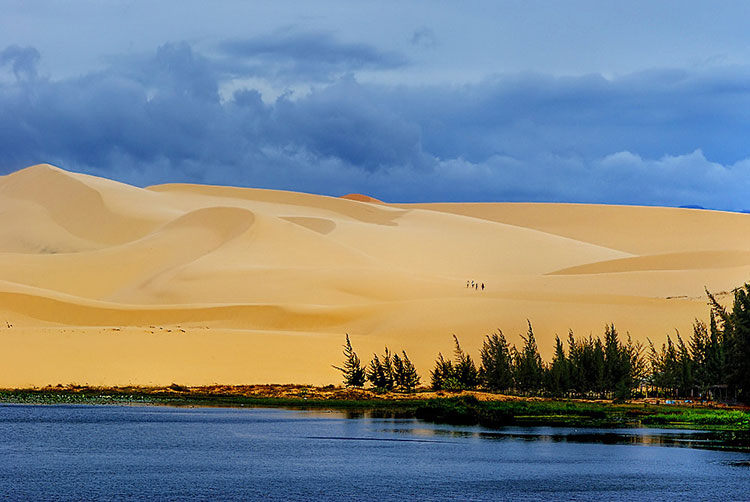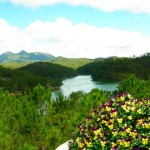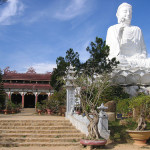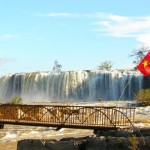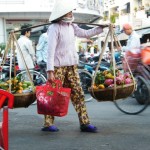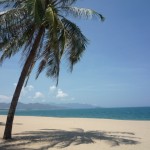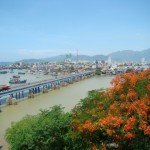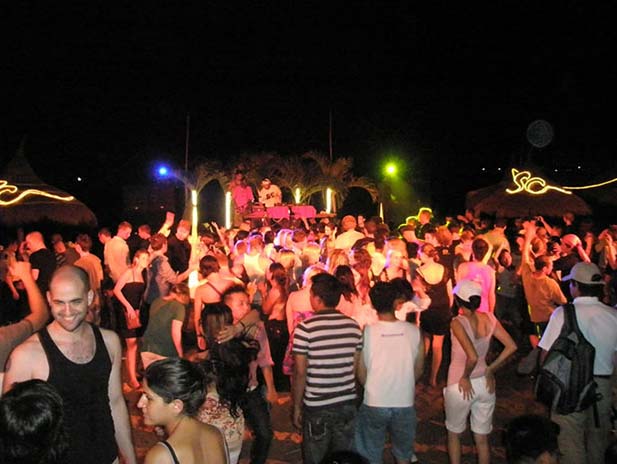“It’s a dangerous business, going out your door. You step onto the road, and if you don’t keep your feet, there’s no knowing where you might be swept off to.”
-Bilbo Baggins
This is a continuation of Part 1 – Departure from Saigon.
It was time to leave Ho Chi Minh City behind and embark on a journey through a new and unusual land. The culture and customs of Vietnam are an entire world apart from those I grew up in back in suburban Southern California. Over the next two months I would become a first-hand witness to an exotic and wild country; home to a warm, hospitable people who have impacted me and my worldview deeply.
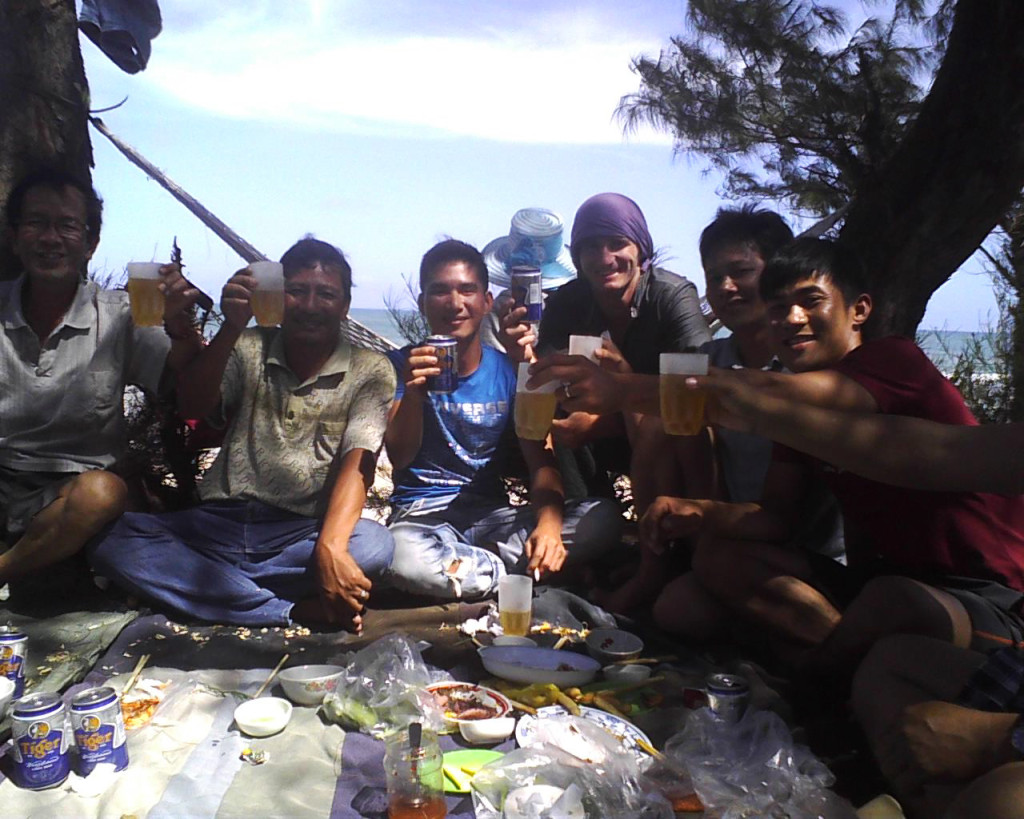
Overall, my impression (perhaps influenced by my time spent in Saigon) has been that the Vietnamese are very autonomous and fiercely independent people. Individuals here are very entrepreneurial, and libertarian. They take responsibility for themselves. A recent survey ranks Vietnamese as the most pro free-trade in the world. Perhaps in the modern age this is a result of backlash against a dysfunctional and repressive socialist government which has held the country back, economically, for decades.
When the Northern communist tanks rolled over the front gate of South Vietnam’s government compound in Saigon 1975 they drug the country into the economic dark ages. Although well-suited to win a war, they proved less able at running a peacetime government, and Vietnam became one of the most politically isolated countries in the world after the fall of the Soviet Union ten years later. It’s just my theory, but I believe that as a result of all this, Vietnamese have developed a doctrine of stern self-reliance.
To further complicate internal political matters, hundreds of thousands of South Vietnamese were taken prisoner and sent to “reeducation camps” to be indoctrinated in to their new roles within the new government system. In socialist theory, “capitalist revolutionaries” can become faithful socialist party members through reeducation through labor. Many South Vietnamese suffered and died in these internment camps. This treatment and other slights have left behind a lingering resentment towards northerners in the hearts of Southern Vietnamese people. There is also a widespread distrust and resentment towards China, Vietnam’s traditional enemy.
As it turns out, Vietnamese is perhaps the most difficult language to pronounce that I have ever encountered. The closest comparison I can draw to Vietnamese is Brazilian-Portuguese. First, both languages contain heavy intonations that make it very difficult to understand for a non-native. Even though Portuguese looks very similar to Spanish when read, it sounds completely different and unintelligible when spoken. In the same sense, although Vietnamese uses the Latin alphabet in its writing system, it is impossibly hopeless for a native English speaker to try to read the words as we know them.
As a small example, the letter “D” in Vietnamese sounds like “Y.” I know, it’s crazy right? Only the letter “D” with a crossbar sounds like the “D” that we know. The Vietnamese, when adopting the Western alphabet, took many liberties to match the letters to their own language’s tones and sounds.
It was so difficult that during my entire time in Vietnam, I could never even ask “How are you?” in the native tongue and pronounce it in a way that people could understand. I know how to say “How are you?” in nearly ten other languages (English, Spanish, Italian, Portuguese, French, Thai, Japanese, Chinese, Burmese, and Korean), and be understood, but in Vietnam no one understands my attempts to speak Vietnamese.
I did, however, learn one particularly valuable phrase – which I kept encountering on banners and signs everywhere I went throughout Vietnam: “Chuc mung nam moi,” which means “Happy New Year.” Everywhere I went in Vietnam, I’d smile and say “Chuc mung nam moi” as my standard greeting. I’d mutter it while stopped at streetlights to other drivers, to security guards, waitresses, and anyone I encountered on the street, drawing smiles in return. With that phrase alone I was more or less able to suffice.
Setting forth from Saigon
When you drive in Vietnam, the experience is markedly different than driving anywhere else in the world. To start, any road signs you come across are only suggestions, and all too often ignored. People, in their haste, willfully drive the opposite way on one-way streets. They’ll cross intersections during red lights. They’ll drive on sidewalks, through public parks, and just about anywhere else a motorbike can reach. Pedestrians, cyclists, animals, and just about everything else gets in where it can fit in amidst the humming chaos of the traffic. There is only one absolute rule of the road: size wins. The bigger the vehicle, the stronger the claim to the right of way.
I set out from Saigon on day one of my journey, bright-eyed, brimming full of rapt anticipation of the journey that lay before me. The suburban outskirts of Saigon quickly proved treacherous – I would soon learn that driving in less urbanized areas means that the informal set of driving rules break down even further. Driving in these areas is borderline lethal if one does not keep their wits about them.
You never know what you’ll encounter in the suburban and rural areas – other drivers driving in any direction (or driving the wrong way), pedestrians walking directly into your path, tractors, bicycles, dogs, cows, potholes, and whatever else your mind can conjure. Further complicating matters, the main highway in most small towns in Vietnam doubles as the “main street” where all the commerce and bustle takes place. The highway is a buzz of activity, and in rural areas in particular, you never know what to expect.
If I could summarize the experience of driving in Vietnam, I would say this: You are never safe while driving a motorbike in Vietnam, UNLESS you remain entirely 100% alert and vigilant at all times. If you maintain your own wits and keep them about you, you will be all right. If your thoughts trail off to somewhere else for even an instant, you put yourself in grave danger. Ironically, the safest places to drive in are in the biggest cities like Saigon and Hanoi – there is safety in being a part of the large “herd” of bikers and going with the flow. That’s the safest you’ll ever be when you drive here.
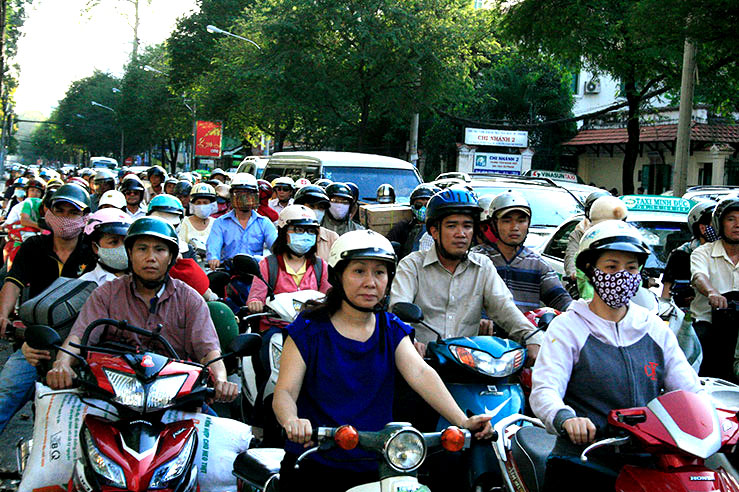 Ladies and gents, start your engines…
Ladies and gents, start your engines…
The only way to find your way around Vietnam is to write down the day’s destination on a slip of paper and put it in your pocket. Then, every time the road splits or takes a detour, stop and show someone your paper, and they’ll point you in the right direction. This is by far the most efficient way to traverse Vietnam by a motorbike. Google Maps is a waste of time here, and good luck trying to find wifi on the road.
Studying the Google maps between Saigon and Phan Thiet, my first destination along the coast, proved a bit perplexing. I vaguely knew the highways and direction I needed to go in and very little else. And as a result of this confusion, I made a big mistake from the very first day.
Upon reaching the outskirts of Ho Chi Minh City, I encountered a large road sign which said “Ha Noi” and pointed straight. As the road split, I continued on what I thought was straight. Unfortunately “straight” seemed open to interpretation in this case. I continued on through a quiet forest of tall pines, largely deserted, until finally arriving at a small city. The road soon crossed several other main roads all leading off in a variety of directions. Perturbed, I stopped at an internet cafe and tried to get some sense of where I was.
I asked one of the youngsters working at the internet cafe, and he kept telling me that if I continued on the road I was going, I would not reach Phan Thiet. He told me I needed to take another road and go back. Bewildered, I couldn’t seem to understand. Eventually I found out that I had unknowingly taken the road towards Vung Tau, south of Saigon, and completely the opposite direction of where I wanted to go. I took another road to get back on course – and ended up going in a huge circle. I lost probably 3 or 4 hours due to my misstep.
I took the road he suggested, and after a while I noticed many of the same landmarks I had seen earlier in the day – I had been on this road before. It was incredibly demoralizing.
I needed to quicken my pace – and soon – as it was already mid-afternoon and I’d made little progress. From that point on, I proceeded along the easterly roads with the utmost haste. I was driving along the one-lane highway at top-speed to reach Phan Thiet before sundown, which – in hindsight – was incredibly dangerous. As the sun began its descent, I passed through lagoons and open rolling hills. As a native Southern Californian, I can always sense when the sea is nearby, and knew I was getting close. My morale was boosted, but night was falling and I still had no idea how much further I had to go.
I rushed past karaoke halls and noodle shops that were just starting to fill up with people. I arrived on the beachfront of Mui Ne in the dead of night. Every possible accommodation was already booked. Many hotels and guesthouses had already locked up for the night, and there was no way in.
Finally, I took a back alley up a hill and found a guesthouse with some people. When they told me all the rooms were full, my heart sank. But I persisted – and pleaded for something – anything they could give me. They set up a mat, pillow, and blanket outside of the building covered in mosquito net. And that little outdoor mattress would be my home for the next 3 days. It actually wasn’t too bad.
Mui Ne – aka “Little Moscow”
One of the most startling things I noticed upon driving down the main avenue through Mui Ne was the smattering of western tourists strolling about. They moved as if on some sort of business; they knew were they going. I did not – I simply picked a destination on a map and now that I’d arrived, it was time to figure out where the heck I fit in to the picture.
I soon learned from local sources that Mui Ne as a destination is overrun with Russian tourists arriving from direct flights from Moscow, fleeing the harsh winters back home. The sheer numbers of them are astonishing; an estimated 20,000 Russian tourists had visited Mui Ne that month. It was a fascinating interaction of cultures; many of the shops and restaurants had signs and menus in both English and Russian, Vietnamese being relegated to third in importance.
While Mui Ne is host to a charming stretch of restaurants, hotels, and shops, it is for the most part a sleepy town where there isn’t a whole lot to do besides eating and shopping. The weather is nice but the beaches directly around the town are not too impressive. Apparently the majority of the beach around the town has been lost due to erosion. Further afield, the beaches improve considerably and there are ancient monuments left behind by the Cham people (the original inhabitants of Southern Vietnam) to discover.
The real highlight of Mui Ne – to those in the know – is the vast collection of sand dunes just north of the town – are they a sight to behold! I set out about mid-day in pursuit of the dunes. As usual, I got lost, as nothing is ever straightforward or simple to find when driving in Vietnam… and I was still inexperienced at this point. It just so happened that another Westerner zipped past me on a motorbike, and since I had no idea where I was going, I followed. The road soon branched off into a dirt road and we parked our bikes in a sandy lot. At this point I approached him, and asked if he knew anything about the sand dunes.
Diego, the traveler, waved a friendly greeting back to me as I approached. He was a fellow backpacker from Sicily and an accomplished traveler in his own right. We were kindred spirits and got along instantly. We bonded over shared interests, from everything from women to travel, and became travel mates.
First we explored the narrow strip of beach which was also probably the windiest place I had ever been in my life. The wind was so strong that it nearly knocked us down. Only at Praia Mole beach in Brazil had I ever encountered winds this strong. The area is a windsurfer’s paradise.
As we explored together, Diego told me more about himself. He recently opened up a small bed and breakfast in his home country of Italy which he operated for several months out of the year. During the low season, he would take months off and go travel. He formerly worked as a music producer in London, but had a difficult time of it. He told me that living in London was so expensive that he had to shoplift foodstuffs from the supermarket in order to survive.

We arrived at the long sought-after dunes not entirely knowing what to expect. Like many tourist jaunts in Asia, the parking area was with throngs of hawkers and peddlers trying to sell their wares to tourists. We parked our bikes in the sand and sauntered on to the large mounds of sand before us.
As we ambled up the first giant mountain of sand, it suddenly seemed as though we had left Vietnam and emerged at a different time and place in the world. As we absorbed the sheer spectacle before us it felt as though we stepped in a portal and emerged into the deserts of Sahara. At the same time, we were in the middle of a peninsula surrounded by clear blue water on three sides. It was a stunning sight.
Bit by travel euphoria and a sense of sheer delight, we shed our inhibitions. Diego and I ran, skipped, jumped, pranced, and slid down the mounds of sand, laughing and shouting like little children. It was a fantastic memory that I’ll never ever forget.
Afterwards, we headed back to the town proper for dinner at an Indian restaurant (Southeast Asia features a smattering of excellent Indian restaurants run by Indian expats offering delicious food at very low prices). We took a stroll along the boardwalk which was lined with a variety of street stalls and vendors catering to the tourists. We talked with two Russian girls, one who was selling her art. We only talked for a short time, but Diego had immediately fallen in love with the girl. Diego elected to remain in Mui Ne for some time to see if he could win her heart.
Three nights had passed and it was time to continue my journey. I still had a long road ahead. Diego and I said our goodbyes, but vowed that we meet up again somewhere on the road, perhaps later on in Ha Noi.
It would be the last time I’d see him.
I set off, alone, on an inland route to reach the mountainous town of Da Lat. Again, I quickly got lost in a maze of dirt roads and farms. Eventually, I found the main road and began my ascent into the mountains. Up, up, up I went along a narrow, winding, and sometimes treacherous road.
Da Lat – City of Eternal Spring
I inched along, progressing further and further up the mountains. The scenery changed rapidly. I was out in true backcountry now. I finally reached the lakeside mountain town and was quite weary from the road, and began immediately searching for accommodation. However, the universe had other plans in store – there was no accommodation within any of the hotels that I could find. Further complicating matters, all of the hotels had doubled their normal rates due to the Tet holiday.
When you travel around the world for 6 months, it is simply not practical to spend $100 a night. For vacationers who take two weeks off a year, perhaps, but it is completely unreasonable for a backpacker. Struggling to find a decent bed, and not willing to be ripped off, I pleaded my case to Mrs Dung, the elderly owner of the Dreams Guesthouse. This was my first successful attempt to negotiate “special” lodging with an innkeeper – which is not too difficult to do if you have a compelling case.
I could not sleep in the kitchen (where her staff slept), but if I was willing, I could sleep inside of the sauna area on the fourth floor. She’d provide a mattress and blanket for me to use. Relieved that I’d be off the streets, I readily agreed.
Home sweet sauna. My deluxe, one-of-a-kind room for 3 nights while in Da Lat.
Da Lat is a quaint little town tucked deep into the central mountains of Southern Vietnam. It’s skipped over by the vast majority of backpackers, which is a mistake. But perhaps it’s for the best that the town remains unaffected by mass tourism so that it maintains its unique, subtle charm.
The town in itself is nice, a little slice of the French Alps in Vietnam. The area around Da Lat – the mountains, waterfalls, valleys, fields, farms, and small towns – is magical.
The stretch leading down from Da Lat’s mountains to the coastal city of Nha Trang is jaw-droppingly stunning. The road is skirted on either side by valleys, plateaus, and majestic mountain ranges standing tall into the heavens. National parks line the road throughout the entire mountain stretch.
Finally, one reaches a steep stretch where the road finally descends from the heights into the fertile coastal grasslands below. The road winds and zigzags down steep roads for tens of thousands of meters. Majestic waterfalls cascade down the rocky surface. This stretch of road is truly a sight to behold. It was as though I had left reality and re-emerged into a painting. Mother nature is the original and most prolific artist, and our efforts to re-create her works simply can not compare.
Nha Trang – Vietnam’s Beachfront Party Scene
I arrived in Nha Trang late in the afternoon and as usual, I had no place to stay the night. I immediately made for the tourist area, a coastal stretch packed with bars, restaurants, tourist shops, and the usual hawkers. Although, this time I was a bit more uneasy. Unlike the subtle and unassuming town of Dalat, Nha Trang is an absolute party town packed with European and local tourists whose main priority was to drink. Overall, the ambiance here was more pulsing, more pretentious than gentle, unassuming Da Lat.
I visited an Aussie pub, bought some much-needed food, and fired up my laptop to get online. A couple of people had contacted me through CouchSurfing. I jumped on Skype to chat with a Vietnamese girl, Thuy, who invited me to meet her at her hotel. She seemed really friendly for some reason, but I didn’t sense any ulterior motives.
We met in the lobby, and I asked if I could leave my things in the room. I dropped my bag onto the floor with a heavy thud. Then we zipped out to meet a couple of American girls (also from Couchsurfing) for dinner.
We joined the two American girls, who dominated the conversation for the entire night. They kept going on and on about their own experiences, and how their journey was a coming of age for them. Occasionally I would offer a bit here or there when I had the opportunity to enter the conversation. But for the most part, dinner was a tedious affair of two American girls demonstrating how completely obsessed with themselves they were. It was a sordid reminder of one reason why I’d left home in the first place.
Fortunately, I had the perfect alibi. I still didn’t have a place to stay for the night, and my things were back in Thuy’s hotel room. So it was easy to explain the situation and extricate myself from the dinner. Thuy and I arrived back at the hotel room, and as I began to prepare my things, she offered to let me stay in the room with her. As I’d been hoping for this, but didn’t want to directly ask, I was relieved, and accepted the offer. I was a bit tired from the road, though, and asked to take a short nap before we headed out again.
The details of what happened next are a bit hazy now.
After a short time, I woke up in a sleepy haze. Thuy was lying on the bed next to me, her hand running up my chest, her lips somewhat crudely attempting to press themselves against mine. Startled, I immediately pulled away. “Wait – I have a girlfriend,” I told her. “We can’t do this.”
She stopped, and we went out to hit the beach party scene. There was a huge concert near the shore with house music, acrobats, and martial artists performing traditional Vietnamese-style kung fu. It was a great time, and we drunk and danced the night away.
We went back to the hotel several hours later and slept on opposite sides of the bed.
The next day, Thuy and I explored the town and the surrounding beaches and mountains. The best way I could describe Nha Trang in Vietnam: the city center is like Waikiki, the north end is like Barra da Lagoa (Brazil), and the area around it is like San Felipe or La Bufadora (Mexico). I got the day off to a good start, jogging and practicing capoeira on the beach. As Thuy and I went exploring the town, she seemed unusually happy. I had the sneaking suspicion that she was under the impression that I was her new boyfriend.
Upon returning to the hotel, I noticed several messages from Vania. It was nearly Valentine’s Day. She missed me and wanted to talk. We’d gotten into an argument while I was in Saigon, and had been mostly out of touch since. We connected on Skype, and I had to tell her about the situation. I told her what had happened last night with Thuy. I told her *almost* everything. I lied when I said that we were sleeping in separate beds.
That night, Thuy kept touching my arm and asking if she could kiss me, and I kept telling her no. The next day, I explained to her that I had to leave. It was time for me to go. She began to cry. I paid her for my half of the room fee, then we went out to share a slightly uncomfortable breakfast together, and an awkward goodbye.
And just like that, it was time for me to hit the great long road again, to begin what would be the longest and most memorable stretch of my journey thus far. I jumped on my bike, revved up the engine, and set off due north.
Stay Tuned for Part 3
My principal reason for coming to Vietnam was to complete a dream adventure which had seemed so fantastical, so impractical at the time – ride a motorbike over 2,200 kilometers from Ho Chi Minh in the south, all the way to capitol of Ha Noi in the northern end of the country.
It was an epic journey that lasted a month and a half, and one that I’ll never forget. The trip was characterized by an unbridled high of freedom the likes of which I had seldom ever experienced before. The perilous journey was also accompanied by the constant threat of danger and near-disaster.
I completed most of this trip alone. I have seen and witnessed so many things – captured so many little moments through my eyes that no one else will ever know. I can’t describe all the little details and highlights experienced from the road, but I will try my best to recap, share the thoughts and feelings of the journey, and share a few of my favorite photos from the trip.
Stay tuned for part 3, featuring the best and most memorable highlights from my motorcycle ride across Vietnam!




